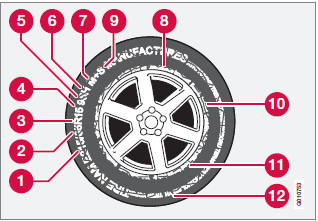 Volvo XC60: Tire designations
Volvo XC60: Tire designations

Information on the sidewall
Federal law mandates that tire manufacturers place standardized information on the sidewall of all tires (see the illustration).
The following information is listed on the tire sidewall:
The tire designation:
NOTE
Please be aware that the following tire designation
is an example only and that this
particular tire may not be available on your
vehicle.
1. 215: the width of the tire (in millimeters) from sidewall edge to sidewall edge. The larger the number, the wider the tire.
2. 65: The ratio of the tire's height to its width in percent.
3. R: Radial tire.
4. 15: The diameter of the wheel rim (in inches).
5. 95: The tire's load index. In this example, a load index of 95 equals a maximum load of 1521 lbs (690 kg).
6. H: The tire's speed rating, or the maximum speed at which the tire is designed to be driven for extended periods of time, carrying a permissible load for the vehicle, and with correct inflation pressure. For example, H indicates a speed rating of 130 mph (210 km/h).
NOTE
The tire's load index and speed rating may
not appear on the sidewall because they are
not required by law.
7. M+S or M/S = Mud and Snow, AT = All Terrain, AS = All Season.
8. U.S. DOT Tire Identification Number (TIN): This begins with the letters "DOT" and indicates that the tire meets all federal standards. The next two numbers or letters are the plant code where it was manufactured, the next two are the tire size code and the last four numbers represent the week and year the tire was built. For example, 1510 means that the tire was manufactured during week 15 of 2010. The numbers in between are marketing codes used at the manufacturer's discretion. This information helps a tire manufacturer identify a tire for safety recall purposes.
9. Tire Ply Composition and Material Used: Indicates the number of plies indicates or the number of layers of rubbercoated fabric in the tire tread and sidewall.
Tire manufacturers also must indicate the ply materials in the tire and the sidewall, which include steel, nylon, polyester, and others.
10. Maximum Load: Indicates the maximum load in pounds and kilograms that can be carried by the tire. Refer to the vehicle's tire information placard located on the B-Pillar for the correct tire pressure for your vehicle.
11. Treadwear, Traction, and Temperature grades: see page 297 for more information.
12. Maximum permissible inflation pressure: the greatest amount of air pressure that should ever be put in the tire. This limit is set by the tire manufacturer.
 Inflation pressure
Inflation pressure
Tire inflation pressure table
The following tire pressures are recommended by Volvo for your vehicle. Refer
to the tire inflation placard (see page 289 for its location) for information
specific ...
 Glossary of tire terminology
Glossary of tire terminology
Terms
The tire suppliers may have additional markings,
notes or warnings such as standard load,
radial tubeless, etc.
• Tire information placard: A placard
showing the OE (Original Equipment ...
See also:
Disabling stop/start
Disabling stop/start
To switch the system off (preventing automatic
stop/start) press the ECO switch. The LED
indicator will extinguish to confirm that the
system is off.
Note: The engine will ...
Coat hooks
CAUTION
■Items that must not be hung on the hook
Do not hang a coat hanger or other hard or sharp objects on the hook. If the
SRS curtain shield airbags deploy, these items may become proje ...
Automatic Operation
The system automatically controls the fan speed, air delivery, air conditioning,
and recirculation to heat or cool the vehicle to the selected temperature.
When the AUTO indicator light is on, the ...
